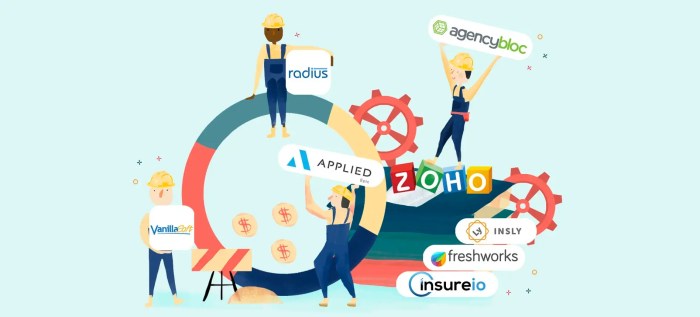Best CRM software for insurance agents is crucial for success in today’s competitive landscape. Efficient client management, streamlined communication, and insightful data analysis are paramount. This guide explores the key features, pricing models, integrations, and user experience considerations when selecting the optimal CRM solution to boost productivity and drive revenue for insurance professionals.
We will delve into the specifics of choosing a CRM, covering aspects like data security, compliance, and the importance of a user-friendly interface. By understanding the various options available and their respective strengths and weaknesses, insurance agents can make informed decisions to optimize their business operations and achieve greater efficiency.
Top CRM Features for Insurance Agents
Selecting the right CRM is crucial for insurance agents to streamline operations, improve client relationships, and boost sales. A robust CRM offers several key features that directly impact an agent’s success. This section details the essential features and their impact on efficiency and profitability.
Contact Management
Effective contact management is the cornerstone of any successful insurance agency. A CRM’s contact management features allow agents to centralize and organize all client information, including contact details, policy information, communication history, and notes from interactions. This centralized repository eliminates the need for scattered spreadsheets or notebooks, ensuring quick access to critical information whenever needed. This efficiency translates directly into improved client service and reduced administrative overhead.
Integrated Communication Tools
Integrated communication tools are a game-changer for insurance agents. A CRM with integrated email, SMS, and phone capabilities enables seamless client interaction from a single platform. Agents can send personalized emails, follow up with SMS reminders, and conduct phone calls all within the CRM, maintaining a complete record of every communication. This unified approach enhances communication consistency, improves response times, and fosters stronger client relationships.
Reporting and Analytics
Reporting and analytics features provide invaluable insights into sales performance and identify areas for improvement. CRMs generate comprehensive reports on key metrics such as lead conversion rates, sales cycles, and client retention. These data-driven insights empower agents to make informed decisions, optimize sales strategies, and ultimately increase profitability. For example, analyzing conversion rates for specific marketing campaigns can reveal which strategies are most effective and guide future efforts.
Lead Management vs. Client Management: Feature Comparison
| Feature | Lead Management | Client Management |
|---|---|---|
| Contact Information | Comprehensive contact details, source tracking | Detailed contact info, policy details, claim history |
| Communication Tracking | Record of initial outreach, follow-ups | Complete communication history across all channels |
| Workflow Automation | Automated email sequences, lead scoring | Automated reminders, policy renewal notifications |
| Reporting | Lead source analysis, conversion rates | Client retention, policy renewal rates, claim frequency |
CRM Software Pricing and Value
Understanding the pricing models and potential cost savings associated with CRM software is vital for insurance agents. This section explores different pricing structures and the return on investment (ROI) of implementing a CRM.
Pricing Models
CRM software typically employs subscription-based pricing models, often with tiered options based on features and user capacity. For example, one provider might offer a basic plan for a single user with limited features, a premium plan with more users and advanced features, and an enterprise plan for large agencies with extensive customization options. Another provider might offer a per-user, per-month fee, while others might charge based on the number of contacts stored.
It is crucial to compare plans across various providers to find the best fit for your needs and budget.
Cost-Saving Measures

Efficient CRM usage leads to significant cost savings for insurance businesses. Automating routine tasks like sending renewal notices or following up on leads reduces administrative workload and frees up agents’ time for higher-value activities. Improved client retention, achieved through better communication and personalized service facilitated by the CRM, further reduces acquisition costs. Streamlined workflows and reduced manual data entry also contribute to significant cost savings.
Return on Investment (ROI)
The ROI of implementing a CRM system can be substantial. Improved sales efficiency, increased client retention, and reduced administrative costs all contribute to a positive ROI. While the initial investment might seem significant, the long-term benefits far outweigh the costs. Quantifying the ROI requires careful tracking of key metrics before and after CRM implementation. By comparing sales figures, client retention rates, and operational costs, the financial impact of the CRM can be clearly demonstrated.
Hidden Costs
- Integration costs with existing systems
- Training costs for staff
- Ongoing maintenance and support fees
- Custom development costs for specialized features
- Potential data migration costs
CRM Integration with Insurance Specific Tools
Integrating a CRM with insurance-specific tools significantly enhances efficiency and data accuracy. This section explores the benefits and key integrations that streamline workflows for insurance agents.
Benefits of Integration
Integrating a CRM with insurance policy management systems provides a unified view of client data, eliminating data silos and improving data accuracy. This integration allows for seamless data flow between systems, reducing manual data entry and the risk of errors. For example, when a new policy is issued in the policy management system, the information can automatically update in the CRM, ensuring all client data is current and consistent.
Key Integrations
Key integrations that streamline workflows include payment gateways for online payments, proposal generation tools for creating customized proposals, and document management systems for secure storage and retrieval of client documents. These integrations create a seamless workflow, saving agents valuable time and effort.
Improved Data Accuracy
CRM integrations reduce manual data entry, thereby minimizing errors and ensuring data consistency. Automatic updates from other systems eliminate the need for manual data transfer, saving time and improving accuracy. This enhanced data accuracy leads to better decision-making and improved client service.
CRM Platform Compatibility
| CRM Platform | Policy Management System Compatibility | Payment Gateway Compatibility | Proposal Generation Tool Compatibility |
|---|---|---|---|
| Salesforce | Various integrations available | Multiple gateway integrations | Several integrations available |
| HubSpot | Integrations through APIs and third-party apps | Various gateway integrations | Integrations available |
| Zoho CRM | Integrations through APIs and third-party apps | Multiple gateway integrations | Integrations available |
User Experience and Ease of Use
A user-friendly CRM is crucial for maximizing productivity and ensuring adoption by insurance agents. This section details the characteristics of an ideal CRM user interface (UI) and user experience (UX).
Ideal UI/UX
The ideal CRM for insurance agents should feature intuitive navigation, a clean and uncluttered interface, and easy data entry. The system should be designed to minimize the time agents spend navigating the software and maximize the time spent interacting with clients and managing their business. Customizable dashboards and personalized views allow agents to prioritize information relevant to their workflow.
Intuitive Navigation and Data Entry
Intuitive navigation is critical for efficient workflow. Agents should be able to quickly find the information they need without extensive training or searching. Simple and efficient data entry processes minimize the time spent on administrative tasks, allowing agents to focus on client interactions and sales.
User-Friendly Features
User-friendly features that enhance productivity include customizable dashboards, automated workflows, and mobile accessibility. These features streamline tasks, improve efficiency, and enable agents to manage their business from anywhere.
Challenges of Complex CRM Systems, Best CRM software for insurance agents
- Steep learning curve: Extensive training may be required, impacting productivity initially.
- Data migration complexities: Transferring existing data can be time-consuming and error-prone.
- Integration challenges: Integrating with existing systems can be complex and require technical expertise.
- High initial cost: Implementing a complex system may involve significant upfront investment.
Mitigation strategies include thorough training, phased implementation, professional assistance with data migration and integration, and careful budgeting.
Security and Data Privacy in Insurance CRM
Data security and compliance are paramount in the insurance industry. This section discusses the essential security features and compliance requirements for insurance CRMs.
Importance of Data Security and Compliance
Insurance CRMs handle sensitive client information, making data security and compliance crucial. Protecting client data is not only ethically responsible but also legally mandated under regulations like GDPR and HIPAA. Breaches can lead to severe financial and reputational damage.
Essential Security Features
Essential security features include data encryption both in transit and at rest, access control measures to restrict access to sensitive data based on user roles, regular security audits and penetration testing to identify vulnerabilities, and robust backup and disaster recovery plans to ensure data availability.
Compliance Requirements
Insurance CRMs must comply with relevant data privacy regulations, including GDPR (General Data Protection Regulation) in Europe and HIPAA (Health Insurance Portability and Accountability Act) in the United States. These regulations Artikel strict requirements for data handling, storage, and security.
Data Protection Measures
Encryption safeguards data both in transit (during transmission) and at rest (when stored). Access control mechanisms, such as role-based access control (RBAC), ensure that only authorized personnel can access sensitive information. Regular security audits and penetration testing proactively identify and address vulnerabilities. Robust backup and disaster recovery plans minimize data loss in the event of a system failure.
Choosing the Right CRM for Your Needs
Selecting the right CRM depends on various factors, including the size and type of insurance agency. This section provides guidance on evaluating different CRM options.
Factors to Consider

Factors to consider include the size of the agency, the number of users, the required features, budget constraints, and integration requirements with existing systems. A small agency might require a simple, cost-effective solution, while a larger agency might need a more comprehensive system with advanced features and scalability.
Step-by-Step Evaluation Guide
- Identify your agency’s specific needs and requirements.
- Research different CRM options and compare their features and pricing.
- Request demos from shortlisted vendors.
- Evaluate the user experience and ease of use.
- Assess the security and compliance features.
- Consider the integration capabilities with existing systems.
- Make a decision based on your agency’s needs and budget.
Cloud-Based vs. On-Premise
Cloud-based CRMs offer scalability, accessibility, and reduced IT infrastructure costs. On-premise solutions provide greater control over data and security but require significant IT infrastructure investment and maintenance.
Decision-Making Flowchart

A flowchart illustrating the decision-making process would visually represent the steps involved in selecting a CRM, starting with defining needs and requirements, progressing through vendor research and evaluation, and culminating in the final selection based on a weighted evaluation of various factors.
Outcome Summary
Selecting the right CRM software is a pivotal decision for insurance agents, impacting efficiency, client relationships, and ultimately, profitability. By carefully considering the factors discussed—from essential features and pricing to integrations and security—agents can confidently choose a system that empowers them to thrive. The investment in a robust CRM is not merely an expense, but a strategic move towards streamlined operations and sustainable growth in the insurance industry.
Clarifying Questions: Best CRM Software For Insurance Agents
What is the average cost of CRM software for insurance agents?
Costs vary widely depending on features, vendor, and pricing model (subscription, tiered). Expect to pay anywhere from a few hundred to several thousand dollars annually.
How long does it typically take to implement a new CRM system?
Implementation time depends on the complexity of the system and the size of the agency. It can range from a few weeks to several months.
What training is involved in using a new CRM system?
Most vendors offer training resources, including online tutorials, webinars, and sometimes on-site support. The extent of training required varies by the CRM’s complexity.
Can I integrate my existing insurance software with a new CRM?
Many CRMs offer integrations with various insurance-specific tools. It’s crucial to verify compatibility before selecting a system.
